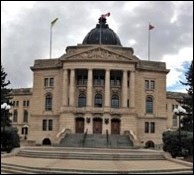SaskPower has made a major announcement Monday setting an objective of 50 per cent renewable power by 2030.
Minister responsible for SaskPower Bill Boyd, along with SaskPower president and CEO Mike Marsh announced the new target, with plans to double the percentage of renewable electricity generation capacity in Saskatchewan by that date.
“An objective of 50 per cent renewable power by 2030 is ambitious, but I’m confident SaskPower can meet the target by taking an ‘all of the above’ approach to planning,” said Minister Boyd in a statement.
“That means a major expansion of wind power augmented by other renewables, such as solar, biomass, geothermal and hydro, to go along with the world leading Boundary Dam 3 carbon capture project and more natural gas generation. This is the framework for a responsible clean energy plan that will reduce greenhouse gas emissions while ensuring Saskatchewan has a reliable, affordable supply of electricity for years to come.”
The news was not unexpected. Premier Brad Wall indicated in the legislature last week that this goal would be announced.
Right now around 25 per cent of Saskatchewan’s generation capacity comes from renewable sources, with 20 per cent hydro and five per cent, or 220 megawatts (MW), from wind.
On the wind side, the government has three new wind power projects either approved or in development that will add another 207 MW of renewable generation by 2020.
The government also noted SaskPower is planning utility scale solar power generation. That would include at least 60 MW of solar with a competitive procurement beginning in 2016.
SaskPower is also reviewing its Net Metering program, which offers customers generating up to 100 kilowatts of renewable energy technology the opportunity to get credit for the unused portion of their electricity.
In addition, they also are investing in geothermal technology pre-feasibility studies to evaluate its potential in Saskatchewan.
To meet the target of up to 50 per cent renewable, the province announced SaskPower procure of another 100 MW of wind generation in 2016 and develop up to 800 MW of new wind generation between 2019 and 2030.
Marsh expressed confidence adding wind and other renewables could be implement in an affordable way.
“The key here is that wind power has become much more economic over the years as the technology has developed. We’ve been able to understand how wind operates on our grid so we can add it in a way that balances our priorities of maintaining a sustainable and diversified generation mix with the delivery of reliable and cost-effective power to our customers,” said Marsh in a statement.
“We’ll take that same approach to adding other clean options to make our renewables target of up to 50 per cent by 2030,” he said.
Robert Hornung, president of the Canadian Wind Energy Association (CanWEA), also welcomes the new target as representing “an important step forward for wind energy in Saskatchewan.
“An initial procurement of 100 MW of new wind energy in 2016, followed by a series of planned future procurements for additional wind energy, will attract significant interest and ensure a highly competitive process that will produce low cost clean electricity generation for Saskatchewan ratepayers.”
Adding more clean electricity builds on SaskPower’s innovative carbon capture and storage initiatives, which the corporation will continue to explore in order to determine how to replace conventional coal-fired electricity generation in light of existing and emerging greenhouse gas emissions regulations.
In the legislature Monday, Boyd said the changes should have the effect on the average consumer’s household power bills by a dollar a month.
“We believe this is a valuable investment in the province’s green energy future,” said Boyd.
“We are proud of the direction that is being taken making sure we are meeting our environmental responsibilities for today and for generations to come, while at the same time ensuring Saskatchewan families continue to enjoy reliable, affordable electricity in our province.”
As expected the opposition NDP expressed disappointment with the Sask. Party’s announcement.
“The goal should be to generate at least 50 per cent of the power entering the grid from renewables,” said Opposition critic Cathy Sproule in the legislature. “Instead, we have a goal to have the capacity to generate no more than 50 per cent of Saskatchewan’s power from renewables by 2030.”
Instead of “rising to the challenge,” Sproule said, the government had offered “a weak, watered-down target.”




